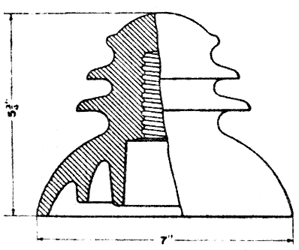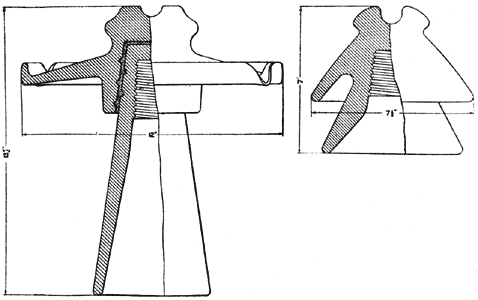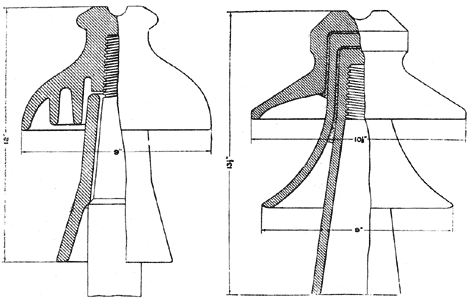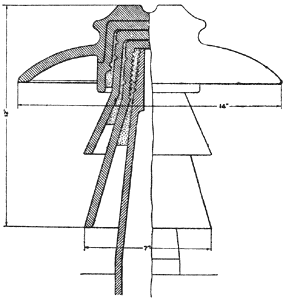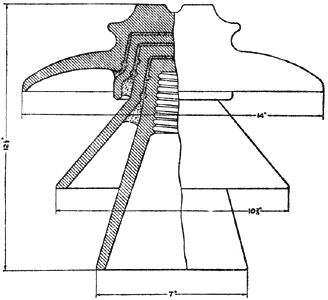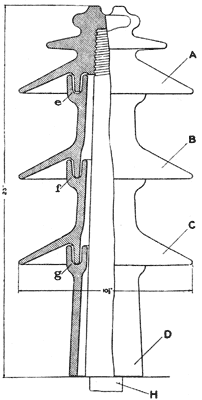Evolution of High-Tension Insulators
|
[Trade Journal] Publication: Electrical World and Engineer New York, NY, United States |
||||||||||||||
|
The Evolution of High-Tension Insulators. IN a paper read before the recent International Electrical Congress, Mr. V. G. Converse gave an interesting account of the evolution of the present types of high-tension insulators. In 1890 the first alternating-current power transmission in the United States used for 3,000 volts a glass insulator of the form shown in Fig. 1. This is an insulator such as is commonly used by the telegraph companies, and is only about 3 in. in diameter. In spite of the predictions that the insulator would not suffice, the plant continued in operation for six years without insulator troubles.
For the famous Frankfort-Lauffen transmission experiments in Germany in 1891, a porcelain insulator with an oil cup was used. No definite information as to the exact shape of this insulator is at hand, but the principle was probably not unlike that of the insulator shown in Fig. 2. Voltages as high as 28,000 to 30,000 were used in these experiments for a limited time. Insulators with oil cups of various forms appeared very shortly afterward in England and the United States. If the insulator was of glass the outer petticoat was usually curved inward and up so as to form an internal groove which would hold oil. A common form for porcelain insulators was to bring down a petticoat from the body of the insulator which would dip into a cup of oil, the cup being made in a circular form and held in place around the pin by a support on the pin. Insulators with detachable oil cups were supplied for the 10,000-volt transmission at Pomona and San Bernardino, Cal., started in 1892. The oil cups were not used, however, as they were found to be unnecessary. Insulators without oil cups being equally effective as those with oil cups, a form similar to that shown in Fig. 3, made of either glass or porcelain came into use. Here the idea was to impede the leakage of current over the surface by introducing petticoats which gave a very long surface between the conductor and the pin. Some insulators had as many as four or five such petticoats. No further increase in voltage is noted until 1895, when we find the Hochfelden-Oerlikon transmission in Switzerland at 13,000 volts. In 1897 we had transmissions in the United States at 16,000 volts. About this time it was found that porcelain insulators which had been formed and pressed in iron moulds had not a sufficiently compact or homogeneous structure and were apt to be punctured in service. A study of the matter showed that really the only effective dielectric insulation of the porcelain was contained in the glaze over the surface of the porcelain. In some cases it was found that the interior body of the porcelain insulator would actually absorb and hold a considerable quantity of water. The manufacture of porcelain was then studied with a view to overcoming these difficulties. The method was resorted to of making the insulator in several thin shells which were glazed separately and then glazed and fired together, the potter's wheel being reverted to in order to make the shells of sufficient compactness. This construction is shown in Fig. 4. It will be noted that a petticoat is here extended down for a distance over the pin for the purpose of further insulating from the pin. Attempts have been made heretofore to extend a petticoat down around the pin, but when the insulator was made in a mould no such long petticoat could be made as is now possible when the insulator is made in several parts. In 1898 we have the first commercial very high voltage plant in operation in the United States, at Provo, Utah. This transmission is at 40.000 volts. The insulator used is of glass, shown in Fig. 5. This insulator has outwardly extending petticoats, the purpose of these petticoats being to provide unexposed surfaces near the wire in order to prevent surface leakage.
In 1900 the demands of the Bay Counties and Standard Electric Companies of California, for 60,000 volts, made necessary a very much larger insulator than had ever been made before, shown in Fig. 6. In this insulator the outer petticoat is carried out almost horizontally, and a gutter is formed on the top near the edge of the petticoat to conduct water away from the cross arm. The top piece of this insulator was originally of porcelain, and the petticoat around the pin, which now amounts to a sleeve extending down the whole length of the pin, was of glass, the glass and porcelain being secured together by sulphur at first and then cement. This type of insulator has been commonly designated the "mushroom" type, from its appearance.
A modification of the outwardly extending petticoat idea is seen in the insulator shown in Fig. 7. This form has had a limited use. While the insulators enumerated have been referred to in order to show the successive steps in the development of the present highest-tension insulators, it must not be understood that such insulators are not still in use. On the contrary, with the exception of the oil insulator, all of these types and many others possessing the same essential characteristics, are in service, at the various voltages for which they have been found adapted. Even the telegraph insulator shown in Fig. 1 has shown good service in certain localities at voltages as high as 10,000. Insulators of the types 3, 4, 5 and 6 are in use for voltages as high as 40,000. In various sizes these same insulators are used for all intermediate voltages up to 40,000. Types 5 and 6 are in use in a few cases at 45,000 volts. Some of these insulators have given good service from the first, while others have failed. It is believed that the failures have been largely due to faulty material. In some cases it has been necessary to replace a whole equipment of insulators because of their faulty construction; in other cases a gradual weeding out has been necessary until the faulty insulators were removed. Occasionally we hear of a plant operating where there has been almost no trouble with insulators, except with such as have been broken by outside interference. In general it is believed that the feeling exists that the line insulator problem for voltages as high as 40,000 has been satisfactorily solved. We are now to the point of consideration of the very highest-voltage insulators—those which are in use for voltages from 50,000 to 60,000. Fig. 8 shows a glass insulator used by the Missouri River Power Company in Montana, for 55,000 volts. This insulator has been in service since 1901. The insulator is in two parts, one a hood 9 in. in diameter, and the other a sleeve set over a pin. The sleeve which is open at the top adds nothing to the dielectric strength of the insulator, its purpose being to protect the wooden pin. Obviously the sleeve would be of little value if a metal pin were used. This type of insulator possesses the advantage of being in two parts, which are separable, either of which can be replaced if broken.
The insulator used for the 50,000-volt transmission at Shawinigan Falls, Que., is shown in Fig. 9. This is of porcelain and made in sections. Each section has a closed top and adds to the dielectric strength of the insulator. Two petticoats, one 9 in. and the other 10 in. in diameter, extend outward and give the effect of one insulator over another. One section extends down around the wooden pin and serves to protect the pin. The sections are held together with Portland cement. This insulator shows the combination of the sleeve around the pin, outwardly extending petticoats and of sections, as first indicated in Figs. 4 and 5. Fig. 10 shows a very large and extended form of the mushroom type, which has recently been put into use on the 60,000-volt transmission at Guanajuato, Mexico. The top section is 14 in. in diameter. The sections are secured together with Portland cement, and the whole is cemented to a hollow metal pin.
For several transmissions under construction for voltages between 50,000 and 60,000, the insulator shown in Fig. 11 has been adopted. Seine of these insulators exceed 14 in. in diameter and weigh as much as 25 pounds.
Abroad insulators are used which are similar to those used in this country. It is probable, however, that they have not been made in such large sizes, also that corresponding sizes are used for lower voltages. The present highest-voltage insulators, then, of which the writer knows, and which may be considered as representing the most advanced state of the art in insulator design and construction, are represented by Figs. 8, 9, to and it. Whatever advantage one may possess over the others will doubtless be shown in course of time. Mr. Converse gave the following requirements for a high-tension insulator: 1. The material must have a high dielectric strength; in other words, it must be strong to resist puncture by the current. In order to fulfill this condition, the material must be continuous, compact and homogeneous, even the most minute crack or fracture being a weakness. 2. There must be sufficient resistance over the surface of the insulator so that there will be no considerable conduction or leakage of current. 3. The distance around the insulator between the wire and the pin or support must be sufficient to prevent the current from arcing. 4. The second and third requirements are dependent upon the slope of the insulator. Its contour must be such that there will be unexposed surfaces which will not get wet or accumulate dirt, salt, etc. as these materials are conducive to leakage and tend to lessen the arcing distance. Evidently the requirements which are dependent upon climatic conditions vary with the locality in which the insulators are to be used. If in a country which is not subjected to heavy rains, sleet or dust storms, the insulator may perhaps be smaller than an insulator required in a locality where the climatic conditions are severe. Usually a larger type of insulator is required for the same voltage in a cold country than in a warmer climate. This may explain why some insulators which have been very satisfactory tinder a given voltage in one locality have utterly failed when tried at the same voltage in another place. In some localities, particularly on the Pacific Coast, the accumulation of salt is so great from the so-called salt fogs that it has been found necessary to have the unexposed surfaces rather shallow and with few petticoats in order that the surfaces may be readily accessible for periodical cleaning. 5. The shape and arrangement of the petticoats should be such that the electrostatic capacity of the insulator will be small. 6. The internal heat losses from conduction and hysteresis should not be such as to appreciably heat the insulator. 7. Mechanical requirements, such as strength, mounting, method of fastening the wire, color, etc., are in general dependent upon the conditions to be met. It does not seem as if details like gutters, spouts, drip points and the like can be considered of much value. They are features which may look well in theory, but can cut but little figure in practice. Certainly the insulation of our high-voltage lines is more dependent upon a good, strong insulator with liberal margins of safety, than upon such refinements. The following tests were advised in order to determine whether insulators will meet the requirements: 1. In order to determine dielectric strength, porcelain insulators should be inverted, with their heads dipping into salt water, the solution extending well over the head of the insulator. The hole for the pin should also be filled with salt water. The predetermined voltage for testing may then be applied to the two salt solutions. Usually a voltage test of several minutes is made. The defective insulators will be punctured in this manner. If the porcelain insulators are made in several sections, the purpose of the sections being to obtain greater dielectric strength, then the sections should be tested individually in the same way. When the sections are cemented or assembled to complete the insulator, it is advised to again test, using the same method, in order to be certain that the sections have not been broken. Every porcelain insulator of a lot should be tested in this manner. If the insulators are of glass, it is best to have every insulator tested in the manner described for porcelain insulators, but as the defects in glass are easily visible it may be only necessary to test a few of a lot in order to determine the strength of the glass, the remainder passing the rigid examination of an inspector who will discard such insulators as have cracks, air bubbles or less than the required thickness. 2. The measurement of leakage over the surface of an insulator is an extremely difficult thing to accomplish and the refined methods which are required are not applicable to factory tests of a large number of insulators. Any leakage of account will be observed in the test for dielectric strength, either by the visible creepage of the current over the surface or by the heating of the insulator. 3. A lot of insulators having passed a preliminary inspection, it is only necessary to test a few in order to meet the third requirement. These may be set up as if in service and the predetermined voltage applied. It is customary to apply the voltage to the line and pin. It is further advised that a voltage be applied across two insulators mounted in the same way, in order to duplicate as near as possible normal running conditions. 4. In order to test for the effectiveness of the contour of an insulator, it is necessary to imitate as nearly as possible the most severe climatic conditions under which the insulator is to operate. Tests of this kind have not been extended farther than to obtain the effect of a heavy driving rain. An insulator mounted as for use should have a broken spray of water thrown upon it at an angle but slightly above the horizontal. The results with this combination may then be noted with a predetermined voltage applied between line and pin, or between two insulators similarly treated. The electrical requirements of a high-tension insulator are at variance with the requirements for mechanical strength in the following respects: 1. In order to increase the dielectric strength, reduce the capacity and lessen the brush discharges, it is necessary to increase the thickness of the head of the insulator. As the thickness is increased, the pin or support in the insulator is removed farther from the strains of the wire and mechanical stresses are brought upon the insulating material which it is incapable of withstanding. Especially is this true if the wire is tied or supported on the top of the insulator. 2. If the point of support of the wire is lowered to the side of the insulator, it is necessary that the insulator be of large diameter at the point of support in order to have the required dielectric thickness. Also with the wire on the side of the insulator, the surface distance is decreased and the length of the adjacent petticoat must be correspondingly increased. 3. No logical or safe arrangement has ever been proposed whereby all the lines of a circuit can be supported otherwise than on the tops of the insulators. In this position the surface of the insulator is exposed to the elements, at least as far as the edge of the extending petticoat adjacent to the line, and the effect is to aggravate the cause for leakage for a certain distance, where it must be checked. 4. The requirement for a larger insulator means one which is more breakable—if of glass, one apparently beyond the present knowledge of how to mould, or how to anneal. The electrical requirements are also. contradictory in this respect —a larger insulator for increasing the arcing distance adds but little resistance to leakage and probably increases the capacity.
Mr. Converse stated that he early foresaw the objections to making insulators of constantly increasing diameters for increasing voltages, and proposed the making of insulators in parts and with outwardly extending petticoats. Such construction is shown in Fig. 12. Other forms of insulators embracing the essential features have been already shown, as in Figs. 9 and 11. The purpose of the construction of the insulator shown in Fig. 12 was to study the effect of the outwardly extending petticoats in resisting arcing of the current between line and pin. The exact details of construction are a top piece, A, screwed onto a wooden pin, H; the two like sections, B and C, and a supporting section, D, resting on the cross arm or support, and holding B and C. D also serves the purpose of protecting the pin. The grooves at e, f and g are for holding an insulating medium, if desirable to insulate between the several parts. These parts being readily separable, it is easy to assemble A and D, or A, D and either B or C. Sections A, B and C were 10 1/2 in. in diameter. Under test the terminals of the testing apparatus being connected at the point for the wire and at the cross arm, the current arced around at the following voltages, with the insulator clean and dry: A and D, 144 kilovolts; A, B and D, 186 kilovolts; A, B, C and D, 225. Under a spray of water at 45° precipitation three-fourths of an inch in five minutes, the current arced at the following voltages: A and D, 118 kilovolts; A, B and D, 157 kilovolts; A, B, C and D, 198 kilovolts. No insulating material was used in the grooves during these tests. There was no tendency for the current to arc between the sections, and there were no serious discharges up the inside of the sections or in the grooves between the sections. This experiment is considered of importance in that the addition of each outwardly extending petticoat section requires a nearly equal additional voltage to produce arcing. The advantage of a properly proportioned insulator with outwardly extending petticoats is, evidently, less diameter for the same resistance to arcing around than an insulator of the mushroom type. As to the surface conditions on insulators of glass and porcelain, no differences have been noted in the conduction or leakage of current. With high tensions, such as water or moisture as falls on the insulator is quickly dispelled or dried off by the leakage of current, high tensions tending always to keep an insulator dry. In general losses on high-tension insulators, until a brush appears, are so small that they are negligible. With the brush the losses increase very rapidly with increase in tension.
|

